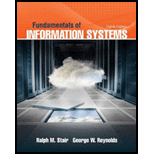
Fundamentals of Information Systems
8th Edition
ISBN: 9781305082168
Author: Ralph Stair, George Reynolds
Publisher: Cengage Learning
expand_more
expand_more
format_list_bulleted
Question
Chapter 1, Problem 4SAT
Program Plan Intro
To determine whether the statement is true or false.
Expert Solution & Answer
Want to see the full answer?
Check out a sample textbook solution
Students have asked these similar questions
This battle room is focused on entry level tasks for a network analyst where you will be given trials and reconnaissance, sensor tuning, log aggregation, SIEM queries, and network analysis.
For this week’s project, complete the following tasks:
From your Project Ares portal, LOG IN
Click on LAUNCH GAME.
Select the region NORTH AMERICA
Click on Battle School
Under the BATTLE SCHOOL pop-up window, click on START TRAINING.
Under the BATTLE ROOMS tile, click on ENTER.
Under the NETWORK ANALYST tile, click on PLAY.
Wait for the Battle Room to load. While loading, the BATTLE ROOM button will display red. Once the Battle Room is loaded, the BATTLE ROOM button will turn yellow and the center of the disk display will indicate CONNECTED. Click on the BATTLE ROOM button to enter the Battle Room.
Below the TASKS folder, make sure you click on INSTRUCTIONS to download the Network Analyst Fundamentals material.
In the Battle Room, under the TASKS menu select task INTRUSION DETECTION.
Complete…
Create a relationship between the common field (Technician Number) of the two tables. Make sure that each client must have 1 and only 1 technician assigned, and each technician can have multiple clients.
2. Create a query to show the Client Number, Client Name, Billed, Paid for clients in Anderson city. Save the query.
3. Create a query to show the Technician Number, Last Name, First Name, YTD Earnings for technicians whose Hourly Rate is greater than or equal to 30. Save the query.
4. Create a query to show Client Number, Client Name, Billed, Paid for clients whose technician number is 22 and whose Billed is over 300. Save the query.
5. Create a query to show the Technician Number, Last Name, First Name, Client Number, Client Name for clients whose technician number 23. Save the query.
6. Create a query to show the Technician Number, Last Name, First Name, Client Number, Client Name for clients whose technician number 23 or 29. Save the query Help please Microsoft office access
Dijkstra's Algorithm (part 1). Consider the network shown below, and Dijkstra’s link-state algorithm. Here, we are interested in computing the least cost path from node E (note: the start node here is E) to all other nodes using Dijkstra's algorithm. Using the algorithm statement used in the textbook and its visual representation, complete the "Step 0" row in the table below showing the link state algorithm’s execution by matching the table entries (i), (ii), (iii), and (iv) with their values. Write down your final [correct] answer, as you‘ll need it for the next question.
Chapter 1 Solutions
Fundamentals of Information Systems
Ch. 1 - Prob. 1LOCh. 1 - Prob. 2LOCh. 1 - Prob. 3LOCh. 1 - Prob. 4LOCh. 1 - Identify and briefly describe two change models...Ch. 1 - Prob. 6LOCh. 1 - Prob. 7LOCh. 1 - Prob. 8LOCh. 1 - Prob. 1.1DQCh. 1 - Prob. 1.2DQ
Ch. 1 - Prob. 1.1CTQCh. 1 - Prob. 1.2CTQCh. 1 - Prob. 2.1DQCh. 1 - Prob. 2.2DQCh. 1 - Prob. 2.1CTQCh. 1 - Prob. 2.2CTQCh. 1 - Prob. 1SATCh. 1 - The ________________ of information is directly...Ch. 1 - Prob. 3SATCh. 1 - Prob. 4SATCh. 1 - Prob. 5SATCh. 1 - Prob. 6SATCh. 1 - Prob. 7SATCh. 1 - Prob. 8SATCh. 1 - Prob. 9SATCh. 1 - Prob. 10SATCh. 1 - Prob. 11SATCh. 1 - Prob. 12SATCh. 1 - The information system worker functions at the...Ch. 1 - Prob. 14SATCh. 1 - Prob. 1RQCh. 1 - Prob. 2RQCh. 1 - Prob. 3RQCh. 1 - Prob. 4RQCh. 1 - Prob. 5RQCh. 1 - Prob. 6RQCh. 1 - Prob. 7RQCh. 1 - Prob. 8RQCh. 1 - Prob. 9RQCh. 1 - Prob. 10RQCh. 1 - Prob. 11RQCh. 1 - Prob. 12RQCh. 1 - Prob. 13RQCh. 1 - Prob. 14RQCh. 1 - Prob. 1DQCh. 1 - Prob. 2DQCh. 1 - What are the two basic types of software? Give...Ch. 1 - Prob. 4DQCh. 1 - Prob. 5DQCh. 1 - Prob. 6DQCh. 1 - Prob. 7DQCh. 1 - Prob. 8DQCh. 1 - Prob. 9DQCh. 1 - Your manager has asked for your input on ideas for...Ch. 1 - Prob. 11DQCh. 1 - Prob. 12DQCh. 1 - Prob. 13DQCh. 1 - Prob. 14DQCh. 1 - Prob. 1PSECh. 1 - Prob. 2PSECh. 1 - Prob. 3PSECh. 1 - Prob. 1WECh. 1 - Prob. 2WECh. 1 - Prob. 3WECh. 1 - Prob. 1CECh. 1 - Prob. 2CECh. 1 - Prob. 3CECh. 1 - Prob. 1.1CSCh. 1 - Prob. 1.2CSCh. 1 - Prob. 1.1aCSCh. 1 - Prob. 1.2aCSCh. 1 - Prob. 2.1CSCh. 1 - Prob. 2.2CSCh. 1 - Prob. 2.1aCSCh. 1 - Prob. 2.2aCS
Knowledge Booster
Similar questions
arrow_back_ios
SEE MORE QUESTIONS
arrow_forward_ios
Recommended textbooks for you
 Principles of Information Systems (MindTap Course...Computer ScienceISBN:9781285867168Author:Ralph Stair, George ReynoldsPublisher:Cengage Learning
Principles of Information Systems (MindTap Course...Computer ScienceISBN:9781285867168Author:Ralph Stair, George ReynoldsPublisher:Cengage Learning Fundamentals of Information SystemsComputer ScienceISBN:9781305082168Author:Ralph Stair, George ReynoldsPublisher:Cengage Learning
Fundamentals of Information SystemsComputer ScienceISBN:9781305082168Author:Ralph Stair, George ReynoldsPublisher:Cengage Learning Enhanced Discovering Computers 2017 (Shelly Cashm...Computer ScienceISBN:9781305657458Author:Misty E. Vermaat, Susan L. Sebok, Steven M. Freund, Mark Frydenberg, Jennifer T. CampbellPublisher:Cengage Learning
Enhanced Discovering Computers 2017 (Shelly Cashm...Computer ScienceISBN:9781305657458Author:Misty E. Vermaat, Susan L. Sebok, Steven M. Freund, Mark Frydenberg, Jennifer T. CampbellPublisher:Cengage Learning- COMPREHENSIVE MICROSOFT OFFICE 365 EXCEComputer ScienceISBN:9780357392676Author:FREUND, StevenPublisher:CENGAGE L
 Principles of Information Security (MindTap Cours...Computer ScienceISBN:9781337102063Author:Michael E. Whitman, Herbert J. MattordPublisher:Cengage Learning
Principles of Information Security (MindTap Cours...Computer ScienceISBN:9781337102063Author:Michael E. Whitman, Herbert J. MattordPublisher:Cengage Learning

Principles of Information Systems (MindTap Course...
Computer Science
ISBN:9781285867168
Author:Ralph Stair, George Reynolds
Publisher:Cengage Learning

Fundamentals of Information Systems
Computer Science
ISBN:9781305082168
Author:Ralph Stair, George Reynolds
Publisher:Cengage Learning

Enhanced Discovering Computers 2017 (Shelly Cashm...
Computer Science
ISBN:9781305657458
Author:Misty E. Vermaat, Susan L. Sebok, Steven M. Freund, Mark Frydenberg, Jennifer T. Campbell
Publisher:Cengage Learning


COMPREHENSIVE MICROSOFT OFFICE 365 EXCE
Computer Science
ISBN:9780357392676
Author:FREUND, Steven
Publisher:CENGAGE L

Principles of Information Security (MindTap Cours...
Computer Science
ISBN:9781337102063
Author:Michael E. Whitman, Herbert J. Mattord
Publisher:Cengage Learning